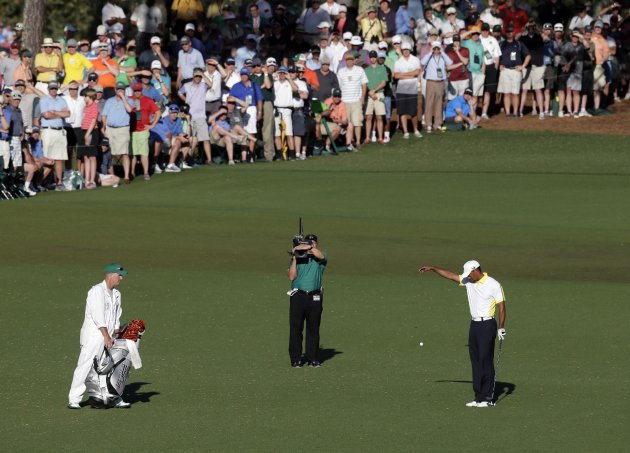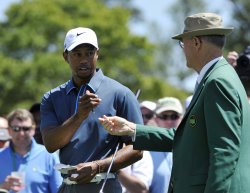Masters makes right call in penalizing, but not DQing, Tiger Woods

Dan Wetzel April 13, 2013 11:49 AMYahoo Sports
View gallery.

Tiger Woods takes a drop at the 15th hole during Round 2 of the Masters. (AP)AUGUSTA, Ga. – Walking down the front veranda of the Augusta National clubhouse, Ernie Els was like everyone else here on a glorious Saturday morning, looking for the latest on Tiger Woods and his disputed drop on the 15th hole Friday.
As the sun rose over the famed course, most people expected Woods to be disqualified after he violated a drop rule on the 15th and then signed what turned out to be an inaccurate scorecard.
Instead, the Masters assessed him a two-shot penalty, allowing him to continue to play because tournament officials originally ruled the drop was fine. At that moment, however, Els was told that the ruling was based on intent. Confusion reigned everywhere.
"Did they change the rule?" Els, a four-time major championship winner, asked.
When offered further clarification, Els just broke into a smile, waved his hands in the air to signify "whatever" and walked off, chuckling.
[Masters 2013 leaderboard: See how Tiger Woods and others are doing]
And that about summed it up, a lot of wonder over how Woods survived, yet acceptance that this, considering it involved Tiger, wasn't that surprising.
The truth is, Saturday morning's decision was both fair and proper because while Woods may have erred on Friday, so too did tournament officials when they failed to discuss the drop with Tiger (and thus accurately assessed a penalty in real time) before he signed what he believed to be a correct scorecard. In fact, tournament officials weren't even aware that he'd made an illegal drop.
So on Saturday, the Masters decided against throwing the player out of the tournament for their own failed and rushed investigation into the original drop.
View gallery.
 While this is certain to create waves of controversy and cries of favoritism, it was the proper course of action.
While this is certain to create waves of controversy and cries of favoritism, it was the proper course of action.It starts with Tiger's approach shot on 15 hitting the flag and bouncing back into the water. From there, Tiger had three options: drop a ball in the designated drop area, go back to the original spot where he hit or put the ball in direct line with where it entered the water.
He did none of those precisely, going a couple of yards back from the original spot but at a slightly different angle. A television viewer alerted the tournament about the discrepancy. An initial video review of the shot by officials, however, determined no violation.
"At that moment and based on that evidence, the Committee determined he had complied with the rules," the tournament stated.
Woods eventually finished his round and signed his scorecard. In subsequent media interviews, however, Tiger explained that he purposefully took his drop "two yards further back" from the original shot.
That acknowledgement, the tournament said, changed the decision-making process.
"After he signed his scorecard, and in a television interview subsequent to the round, the player stated that he had played further from the point than where he had played his third shot. Such action would constitute playing from the wrong place.
"The subsequent information provided by the player's interview after he had competed play warranted further review and discussion with him [Saturday] morning.
"After meeting with the player, it was determined that he had violated Rule 26, and was assessed a two-stroke penalty."
[Related: Penalty against Tianlang Guan at Masters was uncalled for]
However, the Masters decided he should not be disqualified for signing an inaccurate scorecard because the tournament previously ruled inaccurately on the drop and he shouldn't be punished for it.
"The penalty of disqualification was waved by the Committee under Rule 33 as the committee had previously reviewed the information and made its initial determination prior to the finish of the player's round."
In essence, they cut him a huge break. And it's a fair one. While Tiger made a mistake with his drop, none of his comments say that he was knowingly breaking the rules.
There are some who are calling for Woods to disqualify himself, based on the culture of golf. They are saying that regardless of intent, he did, indeed, sign an inaccurate scorecard even if neither he nor tournament officials determined it until some 16 hours after the fact.
"I think he should [withdraw]," David Duvall wrote on Twitter. "He took a drop to gain an advantage."
That would be a magnanimous gesture in the strictest sense of the rules, but is that really what the spirit of the rule was meant to enforce?
Indeed, the very limited competitive advantage gained by a slight location improvement on a fairly easy chip on Friday wouldn't be something someone like Tiger would ever risk penalty strokes to obtain.
Woods made a mistake, but it's the Masters that blew it.
Tournament officials should have asked Woods to explain his drop immediately after the round and before he signed his scorecard. If Tiger had been as forthcoming as he was in media interviews, then the penalty would've been properly assessed prior to the signing of the card.
Instead they didn't bother and went solely with video review. The scorecard controversy was created because the tournament didn't follow protocol.
This could have been nipped in the bud. Instead it exploded into a major controversy, one that left even former champions shaking their head and simply not caring how Tiger Woods managed to stay in the field after signing an inaccurate scorecard, because no explanation is going to satisfy everyone.
Besides, it was a nice day and there was golf to be played.


